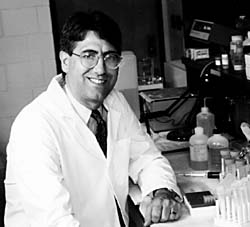FABCenter: Merging Molecular Biology with Animal Production
|
"Improvements ever prevail; and though fixed usages may be best for undisturbed communities, constant necessities of action must be accompanied by the constant improvement of methods."
—Thucydides, |
The University of Minnesota Food Animal Biotechnology Center (FABCenter) is a global leader in the development of genetic maps and biotechnology for food animals, in particular swine and poultry. Drawing from the expertise of the University's Colleges of Veterinary Medicine, Agriculture, and Biological Sciences and Institute of Human Genetics as well from other state, national and international resources, the FABCenter performs and applies basic research related to the development of a better understanding of the genomes of food animals.
 |
| Director Lawrence Schook: the strength of the FABCenter is how its educational and research programs enable rapid utilization of emerging technologies by swine producers, large and small, enhancing their competitiveness. |
The Center prides itself in serving as a first line of contact with food animal producers throughout Minnesota and the United States who seek to improve production and profit through the application of knowledge generated by genetic mapping and molecular biology. As new diagnostic and analytic services emerge from the genome research performed here and at other institutions around the world, it provides the link from the lab bench to the barn, ensuring that new knowledge is accurately and expediently applied to enhancing the quality of, and economic return on, food animal production.
Genetic tests offered by the swine component of the Center include:
- Hal
- SLA Types-major histocompatibility
- Translocations for boars
 "It's going to allow us to decrease the time required to select for those traits that we need to efficiently produce safe, wholesome, good-tasting pork . . . for us to be able to determine those
animals that have specific resistance in their genetic makeup to specific diseases. There's a lot of potential in this. I don't think we know how much yet." "It's going to allow us to decrease the time required to select for those traits that we need to efficiently produce safe, wholesome, good-tasting pork . . . for us to be able to determine those
animals that have specific resistance in their genetic makeup to specific diseases. There's a lot of potential in this. I don't think we know how much yet."—David Reeves, associate professor, University of Georgia, and practicing veterinarian |
At the same time that it works to encourage the application of knowledge already generated, the FABCenter is aggressively pursuing lines of research that will lead to additional services for the producer and veterinarian.
The bottom-line goal of the FABCenter is to use molecular tools and methods to help Minnesota's producers increase the efficiency and quality of production, reduce environmental impacts of their operations by maximizing food output while minimizing resource use, and increase their competitiveness in emerging global markets.
| QTL Quandaries |
|---|
| From the standpoint of genetic mapping, an ideal trait is one that is determined by the working of a single, identifiable gene. However, many economically important characteristics in swine—in particular, characteristics such as growth and carcass quality that vary along a continuum of values—are controlled by the interaction of a number of genes. Known as quantitative trait loci (QTL), the genes that code for such traits are both particularly interesting economically and particularly challenging to map. Fortunately, that's not to say it can't be done. Within the past several years, researchers have established linkage between known swine marker genes and QTL that code for a variety of growth and carcass traits. These traits include rate of weight gain, muscle firmness and ham muscle mass. The successes researchers have had in locating QTLs suggests that we have indeed taken the first steps toward allowing producers to identify which of a boar's offspring have inherited his positive production traits without having to invest the time and expense of growing them all out. |
Questions and Answers
Are pig genome maps being used today to improve production?
Yes. Knowledge we have gained about the location of specific genes within the pig genome has yielded a blood test that allows producers to identify whether an animal carries the gene for porcine stress syndrome (PSS), a hereditary disease that leads to animal death or a reduction in carcass quality.
What other applications are on the horizon?
Like the early explorers developing maps and strategies permitting safe and economical navigation to other lands, mapping the pig genome will be an adventure requiring tremendous efforts. It will be a journey through unknown genetic territory, across which even the most seasoned of researchers will at times find themselves lost.
And like the riches sometimes found by early explorers seeking easier or quicker routes through barely known terrain, unforeseen treasures will also undoubtedly be stumbled upon. Great promise has already been realized for improving carcass and growth characteristics. Other findings suggest that improved litter size will also be achieved through the use of marker-assisted selection.
Many other breedable characteristics have been largely ignored by the swine industry only because we've lacked proper tools and guiding genetic maps until only recently. For instance, such genetic maps will soon identify genes controlling heat tolerance, which particularly affects swine production in tropical climates, and will unlock many mysteries of disease resistance.
Disease resistance has posed a particular dilemma. Its genetic source is complex, yet it attracts our research attention because solving its mysteries will have enormous impact on swine production. It will directly and positively impact on our desire to improve the health of herds through genetic improvement instead of costly antibiotics and vaccines.
Collaborative studies between researchers at the Taiwan Livestock Research Institute and the University of Minnesota are already under way to characterize genetic markers that can be used to identify heat tolerant swine germplasm. The selection of heat tolerant animals will develop new breed stock for emerging markets in Asia, Africa, Central and South America.
The University of Minnesota Swine Center and its researchers are internationally recognized for their contributions to the swine industry. They have provided tremendous leadership in developing both new integrated swine production strategies and the tools for their implementation. Efforts are now under way to permit the incorporation of genotyping information into two extremely successful and powerful tools they have developed: PigCHAMP™ and PigMON™. These are computer programs that let swine producers monitor production data and disease information, helping them make financially sound day-to-day decisions. This combination of genotype information with daily livestock monitoring—an interface between laboratory DNA-based marker-assisted selection and day-to-day farm management—will broadly benefit the U.S. swine industry. Improving the genetic merit and health of a herd will be encouraged simultaneous with meeting packer incentives for improved carcass yield.
Annual symposia and informational publications coordinated by the FABCenter will continue to permit the quick and efficient education of swine producers, and will stimulate new research and permit development of new partnerships.
When will we see these effects?
The entire field of production animal genome mapping is advancing rapidly today. Many of the researchers involved believe that within two or three years, producers will have available a half dozen or more blood tests based on genetic mapping that they can use to make breeding and culling decisions related to disease resistance, growth rate, prolificacy and carcass quality.
What does this cost, and who pays?
Much of the groundwork for animal genome research was laid by researchers involved in the Human Genome Project, a massive federal research program begun in 1990 to produce linkage and physical maps of the human genome. Animal genome research is helping to maximize returns on investment for that project by applying knowledge gained to new, economically significant frontiers.
Specific research related to pig genome mapping is supported in the United States by the U.S. Department of Agriculture (USDA) and in Europe, by a European Community cooperative initiative known as PiGMaP. Other nations and private companies also support some genome research. The cost of individual diagnostic tests that result from knowledge of the pig genome is borne by the individual producer or seedstock source.
How do I get access to this?
Contact the FABCenter to find out what diagnostic tests are currently offered and how you can apply them. Also contact the center if you desire additional general information on genome mapping efforts or on other issues of animal biotechnology.
-
Food Animal Biotechnology Center
University of Minnesota
1988 Fitch Avenue
295 AS/VM Building
St. Paul, MN 55108
Phone: 612/624-2700
FAX: 612/624-7284
Internet: fabctr@maroon.tc.umn.edu
 "Our development of the technology to map and identify individual genes in animals represents a new era of research. It represents a revolution in animal breeding programs that will significantly increase the rate of genetic improvement in animals. "Our development of the technology to map and identify individual genes in animals represents a new era of research. It represents a revolution in animal breeding programs that will significantly increase the rate of genetic improvement in animals."When we combine this new technology with traditional breeding methods and an international database system, it will significantly accelerate the application of this new genetic information on a global basis enhancing both the quantity and quality of food produced from animals." —Roger Gerrits, national program leader, animal production/animal germplasm, Agricultural Research Service, USDA |